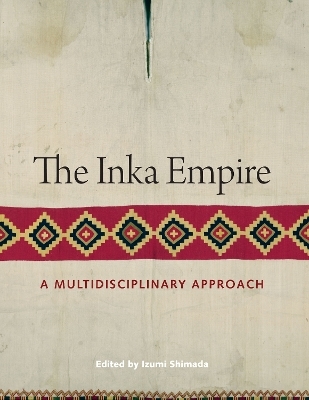
The Inka Empire
University of Texas Press (Verlag)
978-0-292-76079-0 (ISBN)
Massive yet elegantly executed masonry architecture and andenes (agricultural terraces) set against majestic and seemingly boundless Andean landscapes, roads built in defiance of rugged terrains, and fine textiles with orderly geometric designs—all were created within the largest political system in the ancient New World, a system headed, paradoxically, by a single, small minority group without wheeled vehicles, markets, or a writing system, the Inka. For some 130 years (ca. A.D. 1400 to 1533), the Inka ruled over at least eighty-six ethnic groups in an empire that encompassed about 2 million square kilometers, from the northernmost region of the Ecuador–Colombia border to northwest Argentina.
The Inka Empire brings together leading international scholars from many complementary disciplines, including human genetics, linguistics, textile and architectural studies, ethnohistory, and archaeology, to present a state-of-the-art, holistic, and in-depth vision of the Inkas. The contributors provide the latest data and understandings of the political, demographic, and linguistic evolution of the Inkas, from the formative era prior to their political ascendancy to their post-conquest transformation. The scholars also offer an updated vision of the unity, diversity, and essence of the material, organizational, and symbolic-ideological features of the Inka Empire. As a whole, The Inka Empire demonstrates the necessity and value of a multidisciplinary approach that incorporates the insights of fields beyond archaeology and ethnohistory. And with essays by scholars from seven countries, it reflects the cosmopolitanism that has characterized Inka studies ever since its beginnings in the nineteenth century.
Izumi Shimada is Distinguished University Scholar and Professor of Anthropology at Southern Illinois University, Carbondale. He has authored or edited over 200 publications, including Pampa Grande and the Mochica Culture and Craft Production in Complex Societies, and has received awards and honors from the governments of, and other institutions in, both Japan and Peru.
List of Abbreviations
Chapter 1. Introduction (Izumi Shimada)
Part I. Written Sources, Origins, and Formations
Chapter 2. Inkas through Texts: The Primary Sources (Frank Salomon)
Chapter 3. The Languages of the Inkas (Rodolfo Cerrón-Palomino)
Chapter 4. Tracing the Origin of Inka People through Ancient DNA Analysis (Ken-ichi Shinoda)
Chapter 5. Separating the Wheat from the Chaff: Inka Myths, Inka Legends, and the Archaeological Evidence for State Development (Brian S. Bauer and Douglas K. Smit)
Part II. Imperial Infrastructures and Administrative Strategies
Chapter 6. Inka Imperial Intentions and Archaeological Realities in the Peruvian Highlands (R. Alan Covey)
Chapter 7. Funding the Inka Empire (Terence N. D'Altroy)
Part III. Inka Culture at the Center
Chapter 8. Inka Cosmology in Moray: Astronomy, Agriculture, and Pilgrimage (John C. Earls and Gabriela Cervantes)
Chapter 9. The State of Strings: Khipu Administration in the Inka Empire (Gary Urton)
Chapter 10. Inka Art (Thomas B. F. Cummins)
Chapter 11. Inka Textile Traditions and Their Colonial Counterparts (Elena Phipps)
Chapter 12. The Inka Built Environment (Stella Nair and Jean-Pierre Protzen)
Chapter 13. Considering Inka Royal Estates: Architecture, Economy, History (Susan A. Niles)
Chapter 14. Inka Conceptions of Life, Death, and Ancestor Worship (Peter Kaulicke)
Part IV. Imperial Administration in the Provinces
Chapter 15. Collasuyu of the Inka State (Martti Pärssinen)
Chapter 16. Reading the Material Record of Inka Rule: Style, Polity, and Empire on the North Coast of Peru (Frances M. Hayashida and Natalia Guzmán)
Chapter 17. Over the Mountains, Down into the Ceja de Selva: Inka Strategies and Impacts in the Chachapoya Region (Inge Schjellerup)
Chapter 18. At the End of Empire: Imperial Advances on the Northern Frontier (Tamara L. Bray)
Part V. Impacts of the Spanish Conquest
Chapter 19. Three Faces of the Inka: Changing Conceptions and Representations of the Inka during the Colonial Period (Tetsuya Amino)
Authors' Biographies
Index
| Erscheint lt. Verlag | 1.6.2015 |
|---|---|
| Verlagsort | Austin, TX |
| Sprache | englisch |
| Maße | 216 x 279 mm |
| Gewicht | 1901 g |
| Themenwelt | Kunst / Musik / Theater ► Kunstgeschichte / Kunststile |
| Geisteswissenschaften ► Archäologie | |
| Geschichte ► Allgemeine Geschichte ► Vor- und Frühgeschichte | |
| Geisteswissenschaften ► Geschichte ► Regional- / Ländergeschichte | |
| ISBN-10 | 0-292-76079-5 / 0292760795 |
| ISBN-13 | 978-0-292-76079-0 / 9780292760790 |
| Zustand | Neuware |
| Haben Sie eine Frage zum Produkt? |
aus dem Bereich


